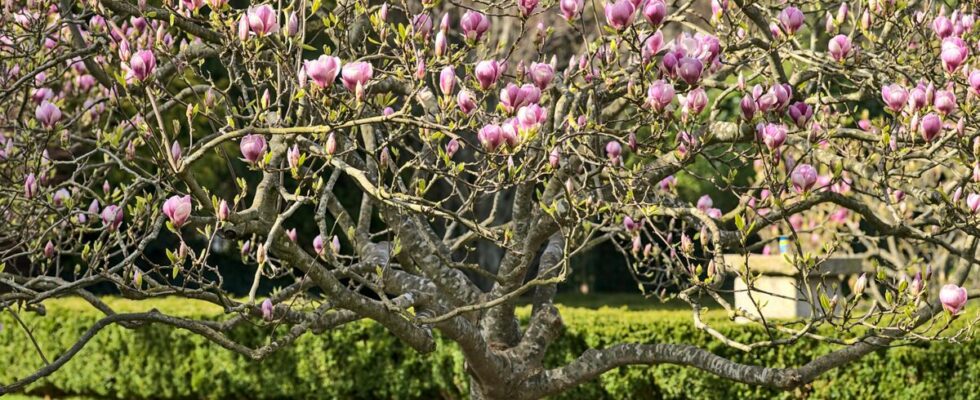Magnolias are trees and shrubs with large, tough, deciduous leaves (which fall in winter) or evergreen, depending on the variety. Its delicate flowers give them incredible charm. Their large petals stretch like stars. Others close in the shape of a bell. Their colors? Pink, purple, cream, white. They were the first flowers to appear in the world, 100 million years ago. In spring and summer, they cover the entire plant. Here are some general indications on the pruning period for this plant, young or adult.
Grandiflora, Stellata, Soulangeana: foliage, flowering and varieties of magnolias (deciduous or not)
There are several varieties of magnolias: the Stellata magnolia, the Soulangeana magnolia or the Grandiflora magnolia.with leathery, glossy foliage and deliciously fragrant flowers“, indicates the Truffaut garden center. Generally speaking, a magnolia only blooms once a year, In early spring. If, however, its buds open early due to a mild summer, it will have fewer flowers the following season. This is part of the consequences of climate change.
What time of year should you prune a small magnolia?
A magnolia does not require any special pruning. Its flowering does not depend on it. However, it is advisable to prune it in the first few years. at the end of April. This will allow the shrub or tree to orient and shape its silhouette, to reshape the foliage. And this, in particular, depending on the available space that you can give it. To modulate its shape from an early age, garden centers recommend pruning “unsightly unwanted branches“. But never more than a third of the entire surface of the tree.
Why should you stop pruning a growing magnolia tree?
As mentioned, a magnolia tree can do without pruning, especially once it is well established and rooted. Also, after 4 or 5 years, its growth will accelerate naturallyit will grow in a pyramidal manner and will no longer require maintenance. Although it has not yet reached adulthood (this will be the case from 5 or 6 m in height), it therefore becomes useless to continue pruning it.
Training size
Pruning is possible but only to balance the branches. It must be said that what most characterizes this tree is its natural shape. As it grows, it may tend to become destructured and rounded with the weight of its flowering, especially if it is in a pot. Preserving it is therefore one of its assets. For this, training pruning can be carried out once a year or every 2-3 years.
Garden centers strongly advise you to proceed before the first signs of spring (the vegetative return) but still outside periods of frost. In deciduous species, it therefore takes place after flowering, when the sap pressure decreases. For evergreen magnolias, it is in February or March. As for dead or fragile branches, it is however possible to remove them as soon as they appear.
How to rejuvenate an old magnolia and take care of it?
Unlike other trees, the magnolia does not require specific maintenance, especially in winter. However, time can have consequences on its vitality: dry, unattractive wood, holey foliage, rounded and heavy tree… To restore youth to an old magnolia, pruning is a good method.
To do this, simply cut low branches with a diameter of less than 2 cm to keep only the carpenter branches. Also keep the upper branches thicker which will circulate the sap better. This allows the tree to concentrate its energy on the most durable branches. Enough to give it, like a haircut, a refresh.
Pruning periods to absolutely avoid (for flowers)
Regardless of the variety and age of the tree, you absolutely must avoid cutting it during spring or summer. This corresponds to its flowering period. This advice also applies to many other plants and flowers.
In fact, pruning a magnolia at these times of the year causes it to bleed profusely due to its significant root pressure. The flow of sap will accelerate and the plant will lose a large part of its reserves. It won’t put him in danger but will severely affect its appearance and in particular the next flowering. The following spring, not only are the flowers likely to be fewer, but above all less robust and pretty.
